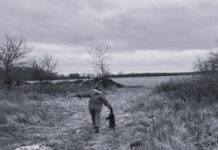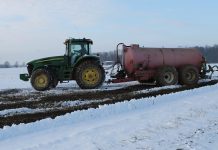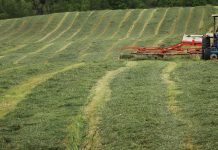As I stare out my window, desperately searching for that first sign of spring, all I see is rain, again.
Normally, I look forward to the rain after a long, cold, snowy winter. The thrill of watching the snow slowly melt away, releasing winter’s icy grip one drop at a time, gives me comfort.
However, that is not the case this year because we have not had much snow. My backyard is not covered in snow; it is soaking wet and dotted with puddles of water because what we have had plenty of this winter is rain.
As I watch the water slowly make its way across the yard and down to the pond, I think about this stormwater runoff. Stormwater runoff is produced when rain falls to the land in quantities that exceed the land surface’s ability to absorb it.
This runoff is a naturally occurring event; however, as people use or alter the land, this runoff can increase in volume and velocity, and pick up pollutants before discharging into a stream or waterway.
Management
Stormwater management has become an important tool in the fight to conserve and preserve our water. So what exactly is stormwater management? It is the process of controlling and processing runoff so it does not harm the environment or human health.
The fundamental goals of stormwater management are to mimic the way runoff left the site before development and to prevent water pollution. Under natural conditions soil and vegetation absorb rain, making it part of the living ecosystem.
The water is suspended by organic matter and soil pores so it is available to plant roots; microorganisms break down pollutants and convert them into nutrients for the plants. The soil can store these intermittent rain events into a regular supply of moisture.
How it works
Typically, most rainstorms are not enough to fully saturate the soil, leaving only a small percentage of the rainwater to become runoff and what does become runoff is slowed down by vegetation which allows time for pollutants to settle out before reaching water ways. In contrast, the impervious surfaces associated with land development prevent water from infiltrating into the soil, contributing to the amount of rainwater becoming runoff.
In urban areas with a large concentration of roadways, sidewalks, parking areas, buildings, and other impenetrable surfaces, even small rain events can produce stormwater runoff.
To address this problem, many drainage ditches and stormwater systems have been installed; however this rapid concentration of water flow affects the hydrologic cycle by increasing the water pollution and flooding potential, decreasing the stability of channels, and reducing ground water levels.
These early efforts to manage stormwater are not only ineffective for the quantity of stormwater but the quality of stormwater as well.
The underlying philosophy was to treat stormwater as a nuisance problem and to get rid of it as quickly as possible. Fortunately, stormwater is now regarded as a resource instead of a nuisance.
What it is
Stormwater is, after all, rain water and rain water is the ultimate source of the water we use in our daily activities and the source of the water which supplies our streams. Sound stormwater management efforts now attempt to address both the quantity and the quality of stormwater runoff.
To accomplish this, best management practices are utilized to control, collect, convey and cleanse stormwater before it enters waterways. Construction sites which will disturb one acre or more of earth must submit a Stormwater Pollution Prevention Plan outlining the BMPs that will be installed to address stormwater management issues.
The plans are reviewed for compliance with both the Ohio EPA’s National Pollutant Discharge Elimination System permit, as well as local regulations that pertain to water quality. There is no denying that land development is a vital part of our economic and social well-being; however, it should not take precedence over the conservation and protection of our natural resources we need to survive.
By using stormwater management practices to filter pollutants and slow runoff velocity, we are taking the necessary steps to conserve and improve one of our most important resources — our water.
So, while you may not think about stormwater runoff or management when you gaze out your window at the falling rain, our office does.













Jodi,
Well written. It is amazing how simple it is and how complicated we make it.